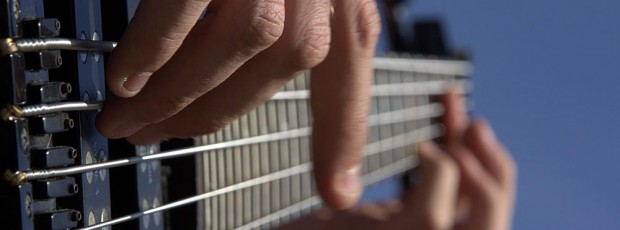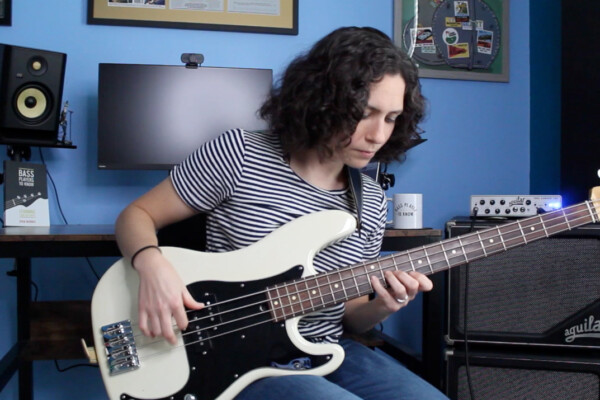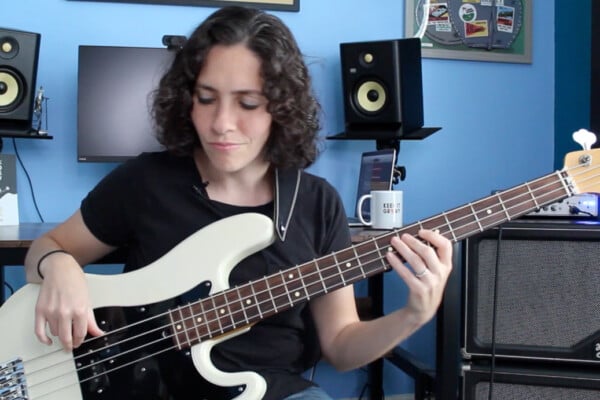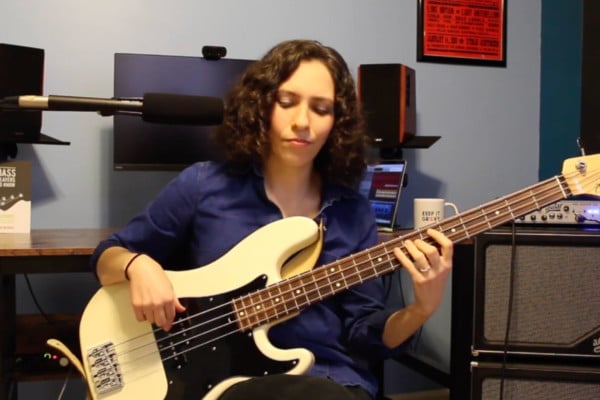Building Bass Lines: Navigating More Changes

Q: I have recently begun playing with a pop artist who writes what I would call “chord heavy” songs. These are not your typical I-IV-V tunes, and they definitely aren’t “riffy”; they are tunes with intricate verse and chorus progressions and extended bridges. I have been going off the lead sheets for now, but my question is how can I navigate these progressions by playing catchy lines, not just peddling roots?
A: This topic is related to columns I’ve written about how to practice playing through changes (here is one of many).
Essentially, it sounds like you need to develop a broader understanding of how to implement the use of harmony on your fretboard. Or, in other words, what notes are available to you for every chord.
Now, you did mention that it’s a pop gig, so for much of the time, you very well may just want to navigate the roots and 5ths of the chord changes.
I play with a number of pop groups, most notably with Gino Vannelli (who had a number of hits in the 70’s and 80’s and is known for having ‘player’ heavy bands that draw from the jazz and fusion pool – people like Jimmy Haslip, Alain Caron, David Garibaldi and so on). His songs are incredibly derivative of the jazz world of harmony – very intricate arrangements and some really interesting changes.
For me, this means that I am primarily developing lines that will work through the changes and still very much supporting the harmony with roots and chord tones, but it becomes very important to fully understand the changes, as they are full of slash chords, upper harmony tensions, altered chords, etc.
For example, it becomes an important part of a good sounding line to know that this is not just a Bb Major-ish chord but a G-7/Bb and that the G-7 is voiced more like a Dorian minor with an E Natural. This means that I would need to hit an E natural and not an Eb, if I was to choose that note to transition to an F or D chord of some kind (or just in a fill). See what I mean?
This gig requires that you have done your homework when it comes to jazz harmony and navigating jazz style changes.
As in the lesson in the column linked above, I would buckle down with the Real Book and start working those arpeggios and scaler patterns over jazz changes. If you prefer to keep the pop genre in tact, that could make it even more fun for you. Try playing solid poppy or R&B style bass lines through tunes like “Stella by Starlight”, “Blue in Green” and “Falling Grace”.
Or, you can even just take charts from that band and do the same type of work with it.
Stevie Wonder’s music is a great study tool for this kind of playing. Many of his songs are really quite advanced harmonically, but you would never know it as a casual listener. A study of Nate Watts and his approach might be in order as well (never hurts anyway… Nate’s a baaaaad dude).
The ability to strongly navigate complex changes in real time comes slowly and takes a lot of work but comes with a huge payoff with regard to your ability to play some great bass.
Like I said, it being a pop gig, your job will still revolve around the lower structure harmony but a developed understanding of the upper structure harmony will really enhance not only your ability to shift seamlessly through changes without hitting those weird unexpected notes but any licks or fills will really serve to enhance the tune and you’ll sound much better in the process.
Just remember: don’t get hung up on the need to show people how well you can play through changes. Pick your moments and when you’re on the gig, focus on tasteful and solid bass lines. If you can really lock it in but display a greater understanding of whats really going on harmonically than your average bass player off the street, you will look fantastic in the eyes of the songwriter and even better, the band will sound that much better for it!
Readers, what’s your approach? Tell us about it in the comments!
Photo by Rolf Lübke
Have a question for Damian Erskine? Send it to [email protected]. Check out Damian’s instructional books, Right Hand Drive and The Improviser’s Path.




Jimmy Haslip had a great article in Bassplayer on how to work through out of the ordinary chord changes way back when…wonder if it is still available?
Study the Carol Kaye stuff on chordal tones, and the use your ears. You may not need to hit the tonic on every chord. In fact, I’m sure you won’t.
Can you explain this concept please: “it becomes an important part of a good sounding line to know that this is not just a Bb Major-ish chord but a G-7/Bb and that the G-7 is voiced more like a Dorian minor with an E Natural.”
If I was in the key of Bb and came upon a G-7/Bb I’d see this as the vi chord in first inversion. I would not be thinking Dorian minor… How did you get from a vi chord in 1st inv to a Dorian minor?
If I had mentioned the key of Bb, I would agree. However, I was thinking outside of that tonality. For example, a jazz tune which modulated and moves around harmonically. Say, a II-V resolving to F but with a specific bass line in mind or any non-diatonic tune. It could be moving to an F#dim/A chord. Chromatic descending bass line… The F major triad would have an E, as an example
Sorty, typing on my phone. F major II-V would have an E